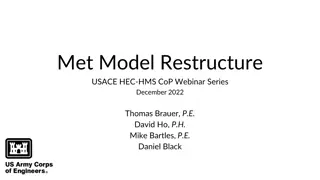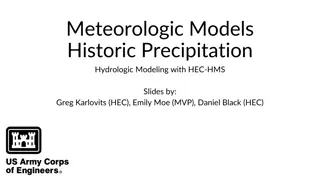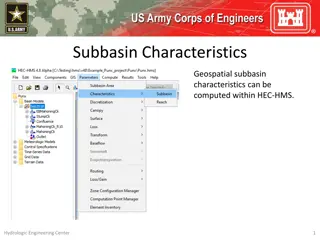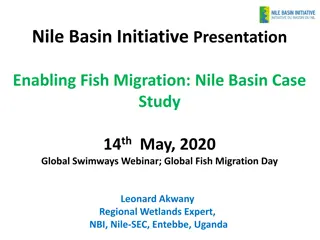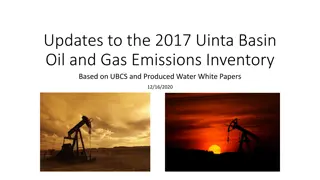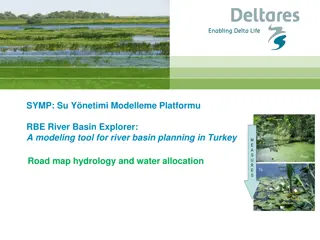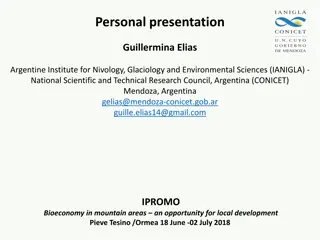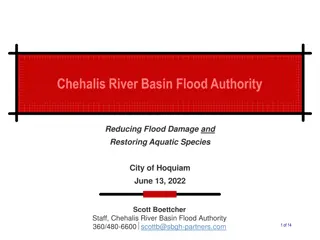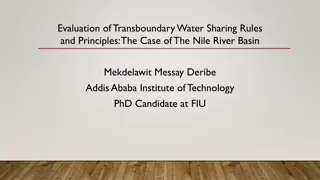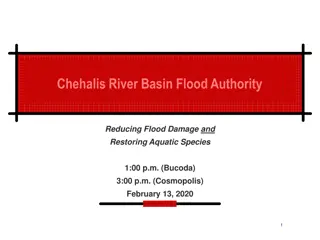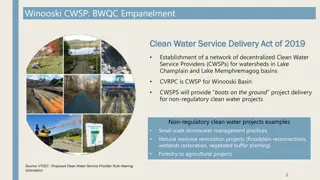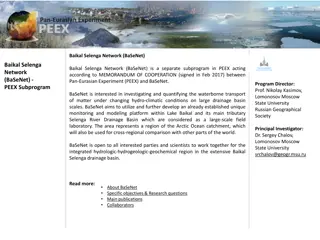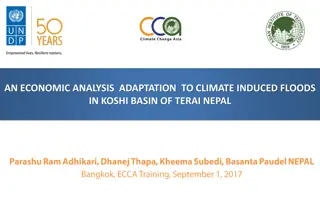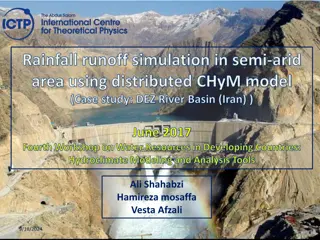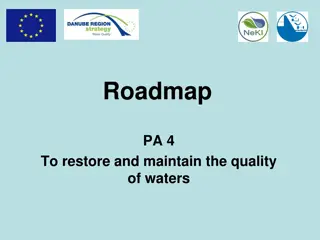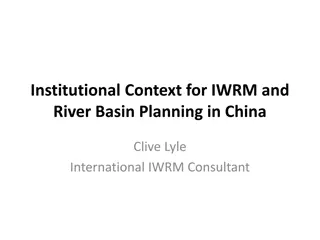Rainfall-Runoff Modelling Using Artificial Neural Network: A Case Study of Purna Sub-catchment, India
Rainfall-runoff modeling is crucial in understanding the relationship between rainfall and runoff. This study focuses on developing a rainfall-runoff model for the Upper Tapi basin in India using Artificial Neural Networks (ANNs). ANNs mimic the human brain's capabilities and have been widely used i
0 views • 26 slides
Overview of Army Modeling and Simulation Office
The U.S. Army Modeling and Simulation Office (AMSO) serves as the lead activity in developing strategy and policy for the Army Modeling and Simulation Enterprise. It focuses on effective governance, resource management, coordination across various community areas, and training the Army Analysis, Mod
1 views • 8 slides
Restructuring of USACE HEC-HMS Meteorologic Model
Significant modifications have been made to the HEC-HMS meteorologic model to enhance modeling tasks' ease and intuitiveness. The Met Model Restructure updates in versions 4.9 to 4.11 streamline meteorologic processes, introduce new features like automatic linkages and zonal editors for snowmelt, an
0 views • 19 slides
Historic Precipitation Hydrologic Modeling with HEC-HMS Slides by Greg Karlovits, Emily Moe, Daniel Black
Delve into the world of hydrologic modeling with HEC-HMS through a detailed presentation by experts Greg Karlovits, Emily Moe, and Daniel Black. Explore meteorologic models, atmospheric boundary conditions, basin modeling, and simulation runs in this informative slide series.
0 views • 12 slides
Capacity Zone Modeling for Forward Capacity Auction 17 Results
This presentation unveils the Capacity Zone modeling calculations for Forward Capacity Auction 17 associated with the 2026-2027 Capacity Commitment Period by ISO-NE PUBLIC. It delves into boundary definitions, import-constrained zone modeling, and market rules guiding the assessments and modeling pr
0 views • 16 slides
Distribution Feeder Modeling and Analysis Overview
This document delves into the modeling, optimization, and simulation of power distribution systems, specifically focusing on Distribution Feeder Modeling and Analysis. It covers the components of a typical distribution feeder, series components, Wye-Connected Voltage Regulator modeling, and equation
0 views • 14 slides
Understanding Data Modeling vs Object Modeling
Data modeling involves exploring data-oriented structures, identifying entity types, and assigning attributes similar to class modeling in object-oriented development. Object models should not be solely based on existing data schemas due to impedance mismatches between object and relational paradigm
0 views • 17 slides
Evolution of Modeling Methodologies in Telecommunication Standards
Workshop on joint efforts between IEEE 802 and ITU-T Study Group 15 focused on information modeling, data modeling, and system control in the realm of transport systems and equipment. The mandate covers technology architecture, function management, and modeling methodologies like UML to YANG generat
1 views • 16 slides
Understanding Geometric Modeling in CAD
Geometric modeling in computer-aided design (CAD) is crucially done in three key ways: wireframe modeling, surface modeling, and solid modeling. Wireframe modeling represents objects by their edges, whereas surface modeling uses surfaces, vertices, and edges to construct components like a box. Each
1 views • 37 slides
Understanding Subbasin Characteristics in HEC-HMS
Subbasin characteristics play a crucial role in hydrological modeling within HEC-HMS. Before computing these characteristics, the basin model must have georeferenced subbasins in the GIS. Various parameters such as basin slope, relief, elongation ratio, drainage density, and flowpath lengths and slo
0 views • 13 slides
Mathematical Modeling and Error Analysis in Engineering
Mathematical modeling plays a crucial role in solving engineering problems efficiently. Numerical methods are powerful tools essential for problem-solving and learning. This chapter explores the importance of studying numerical methods, the concept of mathematical modeling, and the evaluation proces
0 views • 10 slides
Introduction to Dynamic Structural Equation Modeling for Intensive Longitudinal Data
Dynamic Structural Equation Modeling (DSEM) is a powerful analytical tool used to analyze intensive longitudinal data, combining multilevel modeling, time series modeling, structural equation modeling, and time-varying effects modeling. By modeling correlations and changes over time at both individu
0 views • 22 slides
System Modeling and Simulation Overview
This content provides insights into CPSC 531: System Modeling and Simulation course, covering topics such as performance evaluation, simulation modeling, and terminology in system modeling. It emphasizes the importance of developing simulation programs, advantages of simulation, and key concepts lik
0 views • 28 slides
Understanding Object Modeling in Software Development
Object modeling is a crucial concept in software development, capturing the static structure of a system by depicting objects, their relationships, attributes, and operations. This modeling method aids in demonstrating systems to stakeholders and promotes a deeper understanding of real-world entitie
1 views • 65 slides
Sustainable Development through Nile Basin Initiative: Focus on Fish Migration
Enabling fish migration in the Nile Basin through the Nile Basin Initiative is crucial for sustainable socio-economic development. The initiative aims to ensure equitable utilization of water resources, efficient water management, poverty eradication, and economic integration, benefiting the 11 coun
4 views • 13 slides
Coupled Ocean-Atmosphere Modeling on Icosahedral Grids
Coupled ocean-atmosphere modeling on horizontally icosahedral and vertically hybrid-isentropic/isopycnic grids is a cutting-edge approach to modeling climate variability. The design goals aim to achieve a global domain with no grid mismatch at the ocean-atmosphere interface, with key indicators such
1 views • 21 slides
Improvements in Oil and Gas Emission Inventory: Uinta Basin Updates
Uinta Basin's oil and gas emission inventory has seen significant updates in 2017, focusing on improving accuracy through area-specific data collection and enhanced modeling techniques. The discrepancy between top-down and bottom-up emissions measurements has been addressed, leading to better air qu
0 views • 14 slides
Climate Financing and Transboundary Cooperation in the Niger Basin
The panel discussion explores opportunities and challenges in mobilizing climate funds for joint actions in transboundary basins, focusing on the experience of the Niger Basin Authority. It highlights the importance of international commitments, regional cooperation, and sustainable local community
6 views • 7 slides
Basin Manipulation Simulation Analysis Tool Overview
Basin Manipulation Simulation Analysis Tool provides a comprehensive solution for managing and analyzing basin data, including tasks like basin manipulation, simulation analysis, case management, and defining simulation time steps. The tool allows for easy data entry, visualization of simulation res
2 views • 17 slides
The Global Water Crisis and Transboundary Issues in Southern Africa
The global water crisis is a pressing issue affecting millions worldwide, with about 700 million people currently living below the water-stress threshold. By 2025, this number is projected to reach 3 billion. The increasing pressure on shared water resources in countries like Botswana, Namibia, and
0 views • 52 slides
Integrated River Basin Management Approach for Water Resource Planning in Turkey
Modeling tools like RBE River Basin Explorer are being utilized for river basin planning in Turkey focusing on hydrology and water allocation. The roadmap includes projects such as inventory of existing models, improved water allocation, scenario analysis for water scarcity, and capacity building th
1 views • 11 slides
Governance and Cooperation in Transboundary River Basin Management: A Case Study of the Bermejo River Basin
Guillermina Elias, a PhD candidate from Argentina, is researching governance and cooperation in managing the transboundary Bermejo River Basin shared by Argentina and Bolivia. The study focuses on analyzing mechanisms, capacities, stakeholder participation, and resource management from 1995 to 2018
0 views • 6 slides
Chehalis River Basin Flood Authority's Local Projects and Achievements
The Chehalis River Basin Flood Authority, established in 2008, focuses on flood mitigation strategies informed by science to protect residents and communities. Through various projects like the Raymer Street Pump Station in Hoquiam, the authority has significantly reduced flood damage, enhanced comm
0 views • 17 slides
Evaluation of Transboundary Water Sharing Rules: The Nile River Basin Case
This study examines the complex nature of transboundary water management, focusing on the Nile River Basin. It addresses issues such as water scarcity, population growth, and climate change affecting water resources. The research aims to evaluate existing water sharing principles, identify challenge
0 views • 15 slides
Chehalis River Basin Flood Authority Update and Collaboration Highlights
The Chehalis River Basin Flood Authority is making significant progress in reducing flood damage and restoring aquatic species through a Basin-wide strategy. The key messages focus on collaboration among various entities and the importance of a multi-phased approach to protect communities. The backg
0 views • 48 slides
Establishment of Decentralized Clean Water Service Providers in Winooski Basin
The Clean Water Service Delivery Act of 2019 aims to establish a network of decentralized Clean Water Service Providers (CWSPs) for watersheds in Lake Champlain and Lake Memphremagog basins. CVRPC serves as the CWSP for the Winooski Basin, overseeing projects like stormwater management, natural reso
0 views • 5 slides
Baikal Selenga Network (BaSeNet) - Hydrologic Research Program in PEEX
Baikal Selenga Network (BaSeNet) is a subprogram under PEEX focusing on studying waterborne matter transport in the Lake Baikal and Selenga River Drainage Basin. The program aims to quantify hydro-climatic impacts on large scales, utilizing a monitoring and modeling platform. Research objectives inc
0 views • 5 slides
Economic Analysis of Climate-Induced Flood Adaptation in Koshi Basin, Nepal
This project aims to assess the impact of climate-induced floods on agriculture in the Koshi basin of Terai, Nepal. By evaluating flood risk, economic costs, and different adaptation options, the study seeks to enhance resilience in the face of increasing flood occurrences catalyzed by climate chang
0 views • 9 slides
Fire and Smoke Modeling Evaluation Effort (FASMEE) Overview
FASMEE is a collaborative project aimed at assessing and advancing fire and smoke modeling systems through critical measurement techniques and observational data. Led by key technical leads, FASMEE focuses on diverse modeling areas such as fire growth, effects, coupled fire-atmosphere behavior, smok
5 views • 30 slides
Subarea and Highway Corridor Studies: Travel Demand Modeling and Refinements
In this lesson, we delve into subarea and corridor studies focusing on travel demand model refinements, highway network coding, corridor congestion relief, and trip assignment theory. Subarea modeling plays a crucial role in forecasting travel within smaller regions with detailed traffic patterns, t
1 views • 45 slides
Impacts of Climate Change on the Caspian Sea Basin
The Caspian Sea Basin is facing numerous consequences of climate change, including temperature and precipitation variations, sea level fluctuations, regional land degradation, changes in sea ice extent, and increased vulnerability to flooding. Various countries in the region are experiencing differe
0 views • 12 slides
Advancing Computational Modeling for National Security and Climate Missions
Irina Tezaur leads the Quantitative Modeling & Analysis Department, focusing on computational modeling and simulation of complex multi-scale, multi-physics problems. Her work benefits DOE nuclear weapons, national security, and climate missions. By employing innovative techniques like model order re
0 views • 6 slides
Developments in Establishing Quantitative Objectives for Salmon and Steelhead in the Columbia Basin
The Columbia Basin Partnership Task Force, led by NOAA, has been working on setting shared, quantitative objectives for salmon and steelhead in the Columbia Basin. The process involves creating prototype work teams to test and develop these objectives, with a focus on areas like the Snake River Basi
0 views • 47 slides
Rainfall-Runoff Simulation in Semi-Arid Area Using Distributed CHyM Model: DEZ River Basin Study
This case study delves into the simulation of rainfall-runoff using the CHyM model in the semi-arid area of the DEZ River Basin in Iran. The study focuses on water resources management, flood control, and forecasting of flood discharge parameters, emphasizing the importance of accurate modeling for
0 views • 22 slides
Chehalis Basin CFAR Program Overview
The Chehalis Basin Strategy Community Flood Assistance & Resilience (CFAR) Program aims to address flood-related challenges in the Chehalis River Basin through multiple reports and recommendations, emphasizing the need to reduce damage to residences, prevent new development in floodplains, and enhan
0 views • 11 slides
Hydrology Working Group Program Mission 2: Model Preparation and Setup
This content describes the activities of the Hydrology Working Group program Mission 2, focusing on model preparation and setup for the River Basin Explorer project in Turkey and the Netherlands. It covers topics such as water balancing, water supply and demand, infrastructure, and the R.I.B.A.S.I.M
0 views • 15 slides
Capacity of CHYM Model to Reproduce Flow Discharge in the Sanaga River Basin
In this study at the Fourth Workshop on Water Resources in Developing Countries, Adebanji Oluwalani and Nonki Rodric Merim analyze the capacity of the CHYM model to replicate flow discharge in the Sanaga River Basin, Cameroon. The study area, data collection, methodology, results, and conclusions ar
0 views • 12 slides
Roadmap to Restore and Maintain Water Quality
The roadmap outlines actions to restore and maintain water quality, focusing on implementing the Danube River Basin Management Plan, financing strategies, enhancing cooperation at sub-basin levels, and addressing climate change impacts. Key milestones include reports on program measures alignment, w
0 views • 34 slides
River Basin Planning and Administration in China
In China, river basin planning and administration are crucial for managing water resources effectively. The country has seven national-level river basins, each with its River Basin Commission responsible for coordinating water resource management. Examples like the Yellow River and Haihe Basin highl
0 views • 14 slides
NetLogo - Programmable Modeling Environment for Simulating Natural and Social Phenomena
NetLogo is a powerful and versatile programmable modeling environment created by Uri Wilensky in 1999. It allows users to simulate natural and social phenomena by giving instructions to multiple agents operating independently, making it ideal for modeling complex systems evolving over time. NetLogo
0 views • 7 slides


